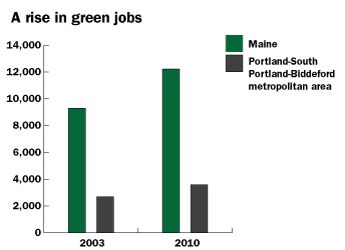High grades for ME's clean economy

Maine's clean economy, a broad-stroke term for pro-environmental goods and services, is getting generally good reviews in a report surfacing this month from the Brookings Institution.
The Washington-based think tank, which five years ago energized Maine’s economy with its report, “Charting Maine’s Future,” says Maine jobs classified within the clean economy grew by 4% a year between 2003 and 2010, while those jobs grew by 3.4% elsewhere in the nation. The state has 12,212 people working in the clean economy with an average income of $34,460, according to the report, “Sizing the clean economy: A national and regional green jobs assessment.” In a surprising turn, researchers found 44% of those Maine workers have the equivalent education of a high school diploma or less.
Jonathan Rothwell, an author of the report, says across the country the clean economy is sparking many middle-wage green collar jobs — such as installers of photovoltaic systems — in ways that were unanticipated. Clean-tech, a sub-sector of the clean economy that includes high-tech renewable energy such as wind turbines and organic polymers for laundry detergents and fuels, has seen job growth surge by 8.3% a year in the United States, compared to the steady 4.2% overall job growth during the same duration. Clean tech is apt to bolster a manufacturing sector in Maine that has been on the brink of retrenchment, he says.
“Manufacturing in the U.S. has been revived by the clean economy,” Rothwell says. The report says about 26% of all clean economy jobs occur in manufacturing, compared to 9% in the overall economy.
There were other surprises in the report: Bangor saw an annual clean economy job growth rate of 7.7%, double the average hiring increases for major cities, while the metropolitan Portland area has been growing clean economy jobs by 4.2% a year.
Maine packs a punch in other metrics: The state exports $14,158 of goods for every clean energy employee, ranking it 31st in the U.S. And although its 12,000-plus jobs places it at No. 44 nationally, the growth of green jobs in Maine between 2007 and 2010 clocks in at 5.8%, enough to earn it the No. 9 spot nationally, according to the report.
The majority of Maine’s clean jobs were concentrated in three areas: conservation, waste management and treatment, and public mass transportation, while two other sectors — sustainable forestry products and energy-saving building materials — also showed significant jobs. The report offered examples of Maine companies making sizeable contributions to the clean economy, including Cianbro Corp. (green architecture and construction services); Hancock Lumber Co. Inc. (sustainable forestry products); Ocean Renewable Power Co. (wave/ocean power); Tom’s of Maine (green consumer products); and Woodard & Curran Inc. (professional environmental services).
Industries such as biofuel production, design and construction services and professional energy services are driving the growth in green jobs. Rothwell says established technologies such as those used in wind power are a bellwether for nascent technologies such as tidal power development.
Forestry-based biofuels, an area already under development in the state, could open untapped manufacturing markets in Maine, says Rothwell.
Old Town Fuel & Fiber, an Old Town company that got a $30 million U.S. Department of Energy grant to add a bio-products refinery to its mill, is working with the University of Maine’s Department of Chemical and Biological Engineering in Orono. Together, they are refining a process to turn a wood sugar extract, a slurry called “black liquor,” into ethanol, butanol and poly-grade lactic acid, a precursor to bioplastics, and is experimenting with turning it into jet fuel.
“It seems to me there is room for very fast growth” in the state of Maine, says Rothwell.
Working together
Ruth Pease, a senior economic research analyst at the Maine Center for Workforce Research and Information, lauded the report for providing the most fine-grained data to date on the contribution of the clean economy sector to Maine’s growth. The authors of the report used an eight-digit coding system and a certification list to identify companies that contribute to the clean economy but may otherwise slip under the radar in state information.
The data, however, “didn’t surprise me,” says Pease. “It’s just a different snapshot. The Brookings data shows a concentration of business that is consistent with [what we know about] Maine’s economy. That we are strong in sustainable forestry products is consistent with the fact the state is strong in the paper products industry.”
Pease cited the report’s observations of Maine’s high concentration of hydrokinetic and forestry-to-biofuels innovation, and pointed out that the state has already developed platforms of research activity to support budding innovation.
Experts agree clean technology rallies job growth around it. Recommendations within the Brookings report include calls for cluster initiatives, and stronger institutional and academic bases to renew the wellsprings of ingenuity. Rothwell says companies that were nested in clusters saw growth that was “1.4% faster compared to companies isolated and established in counties by themselves. It magnifies their strength,” he says.
A 2008 report by the Maine Department of Economic and Community Development and the Maine Technology Institute, “Maine’s Technology Sectors and Clusters: Status and Strategy,” identified 16 clusters at various stages of evolution in Maine, including clean economy industries of renewable energy, environmental technologies and sustainable forestry products.









Comments